Want soft, delicious gluten-free sandwich bread? Then this recipe is for you! It’s easy to make and comes out perfectly every time.
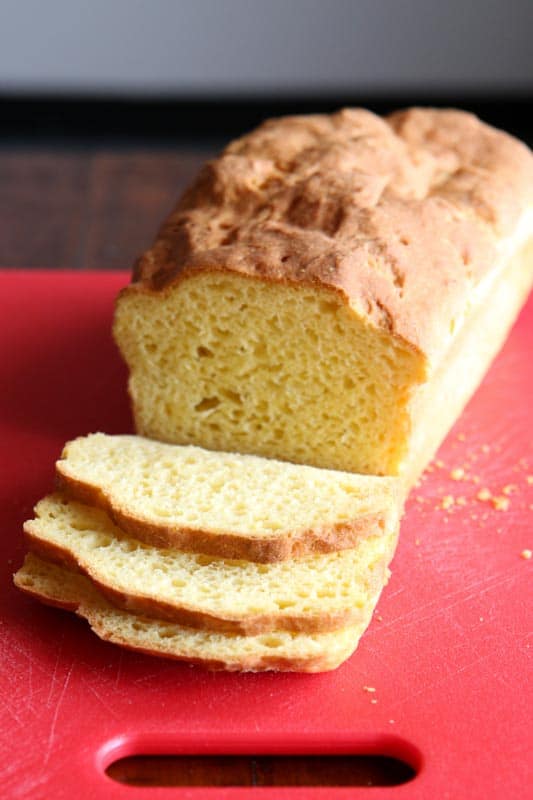
The Best Gluten-Free Sandwich Bread Recipe: Easy, Delicious, and Soft!
Ah, gluten-free sandwich bread. It’s more than a bit of a pain, isn’t it? The pre-made loaves, while light and tender, are expensive and often filled with holes. Homemade recipes save you money but are often dense–and depending on the recipe dry or gummy.
With these problems, what’s a gluten-free eater to do? My advice: don’t give up on sandwich bread!
I’ve baked my own gluten-free sandwich bread for over a decade. In fact, there’s recipes for sandwich bread in both of my cookbooks. But while I love these recipes, I wanted to make a bread that was light and soft. Kind of like–dare I say it?–Udi’s bread but without the holes and the high price tag!
For about six months or so I’ve been working on this recipe. To be honest, I ate way too much bread and butter during these months. That’s the sacrifice I had to make, I guess. 😉 Finally, FINE-AH-LEE, I have a gluten-free bread recipe that’s easy to make, soft in texture, doesn’t fall apart, and tastes great. Oh, and it’s dairy-free, corn-free, and rice-free to boot. I LOVE this bread.
Let’s talk about how to make it. (BTW, I have a lot to say about how to make gluten-free bread. If you just want the recipe, I suggest you scroll down. Way down. Yeah, way, way down. #BakingTeacher #IHeartBreadAndICanNotLie)
How to Make Gluten-Free Sandwich Bread: The Dry Ingredients
Millet Flour
When I set out to make a soft gluten-free bread, I started by looking at the flours and starches I used in previous recipes. Unlike wheat-based bread, which can be made with only flour, water, salt and yeast, gluten-free bread requires a blend of flours and starches. My original bread recipes both use brown rice flour. At the time (old timey gluten-free baker alert!), it was hard to find any gluten-free flours other than rice flour. Using brown rice flour made sense. Today we have lots of other options.
After giving it some thought, I narrowed it down to two flours: millet flour and sorghum flour. Both are tasty and relatively inexpensive. I ended up using Bob’s Red Mill’s millet flour. Have you used millet? I’m in love with it. While brown rice flour can lend a somewhat gritty texture to recipes, millet reminds me of wheat flour. It’s soft. And it contains more fiber than rice flours! Yup! Cup for cup, millet offers twice as much fiber as brown rice flour. A soft texture and twice the fiber? Awesome!
Next up…starch!
Tapioca Starch
Since I was rethinking the flour, I also wanted to rethink the starch. In my first cookbook, Easy Gluten-Free Baking, my sandwich bread used corn starch. In my second, How to Cook Gluten-Free,I used potato starch. For this recipe, it’s all about the tapioca starch.
You might be wondering why you need starch at all. Good question! Wheat and other grains contain a starch called amylopectin. It’s part of their makeup. When combined with a liquid and heated, this starch gelatinizes. It thickens and almost turns jelly-like. If you’ve ever made a stovetop pudding, you’ve seen this happen. One minute the pudding is thin, the next it thickens. This is good news for gluten-free bakers. Without the stretch of gluten, starch helps hold bread together.
Even though grain contains starch, it’s not enough to make a soft sandwich bread. Enter: added starch. Without tapioca starch, this loaf turns out dense and heavy. In the future, we’ll made some rustic bread. Those don’t always need added starch. This loaf does.
The reason I reached for tapioca starch for this recipe is because it adds an almost gluten-like stretch to recipes. Notice I said “almost”. There’s no 1:1 replacement for gluten. It bakes up lighter than both corn starch (which can get a little heavy) and potato starch (which is light but doesn’t add much stretch).
Xanthan Gum
Ah, xanthan gum. (deep breath) Usually the follow-up question to, “Elizabeth, how do I make bread?” is “Why do I need to use xanthan gum?”
Simply put, you need xanthan gum because gluten isn’t present in the dough. Gluten, which comes from the Latin word for “glue”, provides elasticity and strength to traditional wheat-based doughs. If you’ve ever kneaded dough or watched someone throw pizza dough over their head, you’ve witnessed the stretchiness of gluten in action. Without this rubber band-like protein, gluten-free bread dough lacks the essence of what gives bread structure.
Enter xanthan gum.
While I wouldn’t go as far as calling xanthan gum a gluten replacement, it does prevent gluten-free bread from collapsing in on itself. Made from a microorganism called xanthomonas campestris, xanthan gum becomes very viscous and sticky when combined with water. It doesn’t have the same rubber band-like properties of gluten but it does a good job providing structure to gluten-free breads. If you accidentally omitted it from this recipe, you would have a very short, very dense loaf of bread.
Sugar
There’s a wee bit of sugar in this recipe. It helps feed the yeast and helps the crust to brown. Even though it’s only two tablespoons, there’s a big difference in color and flavor between a loaf made with the sugar and one made without. Feel free to use turbinado (Sugar in the Raw) sugar if you prefer.
Salt
Ah, salt! The amount of salt in a bread recipe seems quite small, doesn’t it? There’s only one teaspoon in the entire recipe. However, salt is an essential ingredient in bread dough. It helps enhance flavor, it controls yeast growth (more about this in a sec), and it helps the crust to brown. If you forget to add salt to a bread recipe, the bread will taste flat and the texture won’t be right.
For this recipe, use table salt, not Kosher salt or sea salt. They don’t measure the same (You need to use 1 1/4 teaspoons of Kosher salt to replace the table salt) and sometimes coarse Kosher salt doesn’t fully dissolve in the bread dough.
One other note about salt: when salt is in direct contact with yeast, it will kill the yeast. Never, ever add salt to your water-yeast mixture. You want to add the salt to the flour mixture and whisk everything together. This distributes the salt and keeps the yeast happy. And happy yeast is happy bread!
Baking Powder
What’s baking powder doing in a yeast bread recipe?! I know. I know. Another ingredient to measure (I’m sorry!). During testing of the bread recipe in “How to Cook Gluten-Free”, I wanted the loaf to have a little more rise. Increasing the yeast didn’t provide the lift I wanted. So I tried adding a little baking powder. PERFECT. Since it worked so well, I borrowed the idea for this recipe. It still works great. Commercial baking powder is double acting. This means it releases gas in the bowl when it comes in contact with liquid and then again in the oven when it gets hot. Adding a little lift during mixing and at the start of baking seems to give the yeast a little more room to do it’s thing.
Instant Yeast
The star of the show! Yeast! (woo-hoo!) For some reason yeast makes people nervous. I understand. Unlike other leaveners, like baking powder and soda, yeast is alive. It needs a little bit of special care. Not a lot of care, just a little.
The main thing is water temperature. For yeast to work, you want your water temperature between 105°F and 115°F. For the best results, grab an instant thermometer and take the temperature of the water. At around 120°F, the yeast begins to die and at 140°F, thermal death point kicks in and the yeast totally dies. (#RIPYeast).
For this recipe, I like to use “Quick Rise” yeast. Depending on the brand, this might be called Rapid Rise, Fast Acting, or Highly Active Yeast. This yeast is dried in smaller particles than traditional Active Dry Yeast. Technically, you don’t even need to dissolve it in water. You can add it directly to your dry ingredients, whisk everything together, and go. I prefer dissolving it in water. It’s up to you. If you decide to add your yeast directly to your dry ingredients, increase your water temperature to 120°F.
“Elizabeth! You just said that yeast begins to die at 120°F! Have you lost it?!?”
First, thank you for paying attention. Second, I might have lost it. I can’t keep track of these things. 😉 AnyWAY, about that temperature. It’s higher because the yeast is never in direct contact with the water.
Lastly, water temperature and keeping yeast away from salt is all fine and good. But you need to start with yeast that’s still fresh. I don’t mean cakes of fresh yeast, that’s a different product. I mean check the expiration date on the packet! If it’s expired, toss it and get some new yeast!
BAKER’S NOTE: Is All Yeast Gluten-Free?
Answer: no. While “Saccharomyces cerevisiae” (that’s baker’s yeast to you and me) is a fungus and is naturally gluten-free, some packaged yeast is NOT gluten-free. Always check the label. As of this writing, Red Star’s Platinum yeast was NOT gluten-free. All of their other products are gluten-free. Read those labels!
How to Make Gluten-Free Sandwich Bread: The Wet Ingredients
Now it’s time to talk about what holds everything together, the wet ingredients!
Water
As written, the recipe calls for only 3/4 cup of water. To measure the water, use a liquid measuring cup or weigh the water (more on that below). As mentioned above, water temperature is key to bread baking. Use water that’s around 110°F. If you want to make a rich loaf of sandwich bread, replace the water with milk. Heat the milk to the same temperature as the water. When milk is used, the loaf bakes up slightly darker and has a creamier taste than a loaf made with water.
Eggs
Eggs add fat and flavor to this bread. They also add moisture. Unfortunately, this bread doesn’t do well egg-free. If you look at the photo of this bread, you can see it’s really yellow. That’s because I used local eggs and the yolks were BRIGHT yellow. Did I mention they were bright? When this bread is made with store bought eggs (something I use a lot of the time!), it won’t bake up so yellow. Also, if you prefer a less rich bread, omit the egg yolks and use only egg whites.
BAKER’S NOTE: If you buy your eggs from a local farmer, weigh them before you use them as the size tends to vary. An egg, out of shell, should weight about 50 grams.
Oil
Two tablespoons of fat help to soften the texture of this bread. For this bread, any liquid oil, like olive, canola, or vegetable, works.
How to Make Gluten-Free Sandwich Bread: Measuring
Measuring Dry Ingredients
Successful baking relies heavily on successful measuring. An error in measuring ingredients can cause a recipe to flop.
You have two good options for accurate measuring:
Measuring by Weight
Using a kitchen scale is the most accurate way to measure ingredients. Simply place a bowl on the scale, zero the scale (sometimes called “tare”) and add the ingredients. Zero the scale after adding each ingredient. For this recipe it looks like this: zero —>weigh the millet flour —> press zero—->add the tapioca starch. Done! The rest of the dry ingredients are small and are measured with nested measuring spoons. More on that in a sec.
Measuring by Volume
If you prefer to use measuring cups and spoons, that’s fine. While some claim that it won’t work, I disagree. If you take care when measuring your ingredients, you will be successful. In fact, when I started writing gluten-free cookbooks, few home cooks owned kitchen scales. My entire first baking book relies on volume measures and the recipes work for thousands of bakers.
Here’s how to measure ingredients with a dry measure.
1. Select a set of nested measuring cups. (Prefer metal to plastic. Over time, they won’t warp.)
2. Spoon flour or starch into the cup. Overfill slightly.
3. Level the cup with something straight, like a chopstick or the back of a butter knife.
BAKER’S NOTE: Don’t confuse nested measuring cups with a liquid measuring cup. You don’t want to measure dry ingredients in a liquid measuring cup.
Measuring Small Ingredients: Tablespoons and Teaspoons
Small ingredients are best measured by volume. Many kitchen scales aren’t accurate enough to measure a half teaspoon of salt. For small ingredients use a set of nested measuring spoons. I prefer metal as plastic or those “slider” measuring spoons tend to be less accurate.
For small ingredients, you can dip the spoon right into the ingredients, overfill slightly and then level with something straight.
Measuring Liquid Ingredients
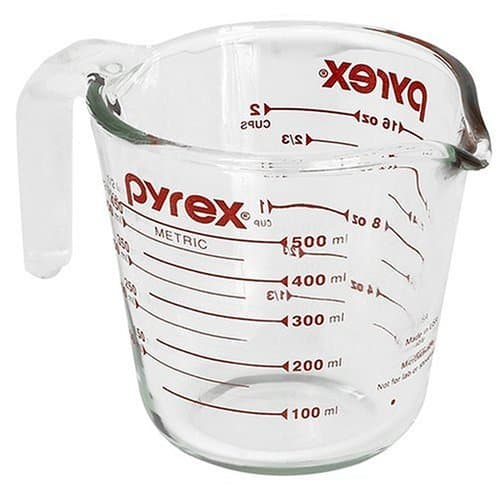
For the water and oil, use a liquid measuring cup, like the one shown above. Fill the cup and squat down to eye level to make sure you have two cups of water. Holding the cup in the air or looking down at it can result in inaccurate measuring. If you are unable to squat down to eye level, Oxo makes an angled measure cup that can be viewed accurately from above.
How to Make Gluten-Free Sandwich Bread: Mixing
Without gluten to hold everything together, gluten-free bread dough looks very different from traditional bread dough. Instead of forming a smooth dough ball, it looks like a thick, sticky cake batter.

The easiest way to mix this thick dough is with a stand mixer. I use a KitchenAid mixer fitted with a flat paddle attachment. With gluten-free bread, you want to ditch the dough hook. It doesn’t mix gluten-free bread well. The paddle attachment, in contrast, does a great job chugging through our dough. Mix on medium-high speed for about three minutes.
If you don’t own a stand mixer, worry not! You can use a handheld mixer for the job. Again, I like my KitchenAid hand mixer for this job. I’ve found other mixers can’t handle the dough. If fact, over the years, I’ve had several readers tell me that they burnt out the motors of their handheld mixers while making gluten-free dough. Yikes!
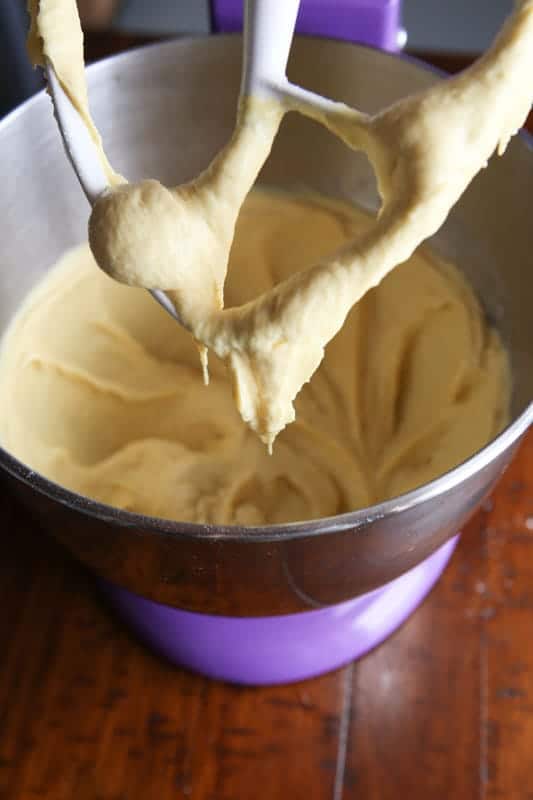
Mix the dough until it’s smooth. You don’t want any dry flour hanging around the bottom of the bowl. Use a flexible spatula to clear around the little bump at the bottom of the KitchenAid mixer.
For this loaf, I use a Chicago Metallic loaf pan. It’s a little smaller than a traditional 9×5 bread pan. In fact, it’s 8-1/2″ by 4-1/2″ by 2-3/4″. If you are going to go to the trouble of making homemade bread, I’d strongly suggest you use this pan. It works GREAT. You end up with a loaf of bread about the size of Udi’s. This is smaller than traditional wheat bread but without gluten, smaller is sometimes better for gluten-free bread.
If you don’t want to invest in new pans, that’s fine! Just know that when this bread is baked in a 9×5 inch pan, it won’t rise as high because the pan is larger than the Chicago Metallic pan.
No matter what pan you use, be sure to spray the pan with non-stick cooking spray before adding the dough.
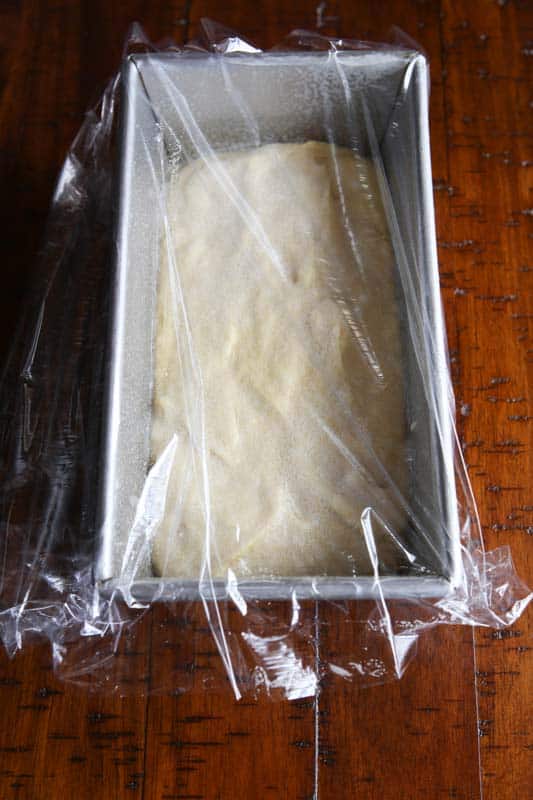
Cover the bread with a piece of plastic wrap that you’ve sprayed generously with non-stick cooking spray. This dough is soft. If you don’t spray the plastic wrap, the dough sticks to it.
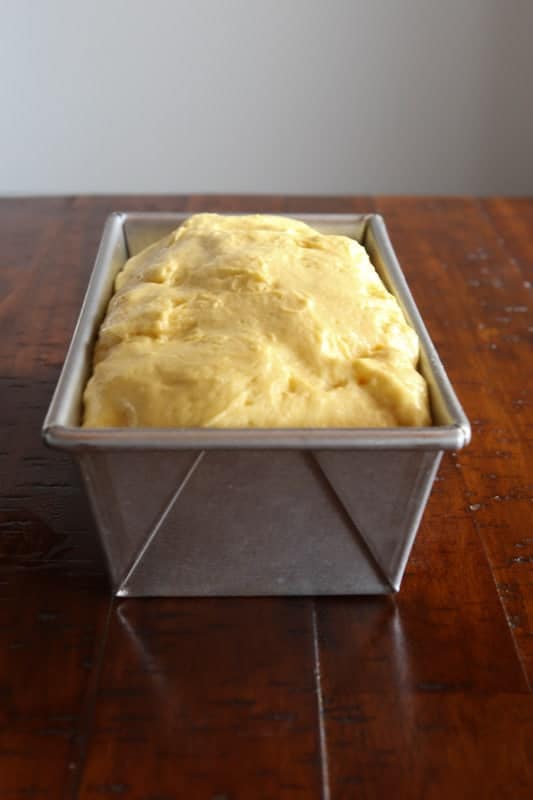
After an hour or so, the dough should have doubled in size. Don’t let it over-rise. While it seems like the higher the rise, the higher the bread, this isn’t true. When dough rises too high, it can collapse during baking. Once the dough doubles, it’s ready to go.
The best place to allow dough to rise is on the counter. If your kitchen is very cold, throw the pan in the oven (be sure the oven is off). You don’t need to find a special spot for the bread. I know some people place their pan of bread on top of the fridge. Um, I don’t remember the last time I dusted the top of my refrigerator. There’s no way I’m putting food up there. 🙂
If you remember that rise time is an estimate, you’re all set. Sometimes bread dough rises fast (usually in the summer) and sometimes it takes its time (usually in the winter.) If after 90 minutes nothing has happened, check to see if you forgot to add the yeast. Occasionally issues with yeast happen but it happens fairly rarely, especially if you follow the directions about yeast above.
How to Make Gluten-Free Sandwich Bread: Baking, Cooling, and Storage!
Finally! It’s time to bake! Yay!
It’s important to preheat your oven before you bake your bread. Something magical happens during the first few minutes of bread baking: the yeast goes into a hyperactive phase. As the temperature of the dough rises, the dough rapidly converts sugars (from the starches in the flour) into carbon dioxide. At the same time, the water in the dough turns to steam. This boost of carbon dioxide and steam help the dough to rise. Oven spring can account for an additional 10% rise.
And then…it all stops. When the temperature reaches 120°F, the yeast hits its thermal death point and dies off. No more rise occurs after this point.

Taking the Temperature
I find it difficult to judge exactly when a loaf of bread has baked all the way through. There’s nothing more disappointing than spending time baking a loaf of bread only to find out that the very center of the bread is under baked. Thankfully there’s a simple solution to this problem: take its temperature. Yup, just like you’d do for a turkey at Thanksgiving!
Stick an instant read thermometer into the center of the loaf. Don’t poke the edges of the bread, the temperature is hotter there and won’t tell you if the center has baked.
The bread should reach 210°F or above. This is slightly higher than the temperature for wheat dough but I’ve found that once gluten-free bread hits 210° F, it’s done.
Cooling
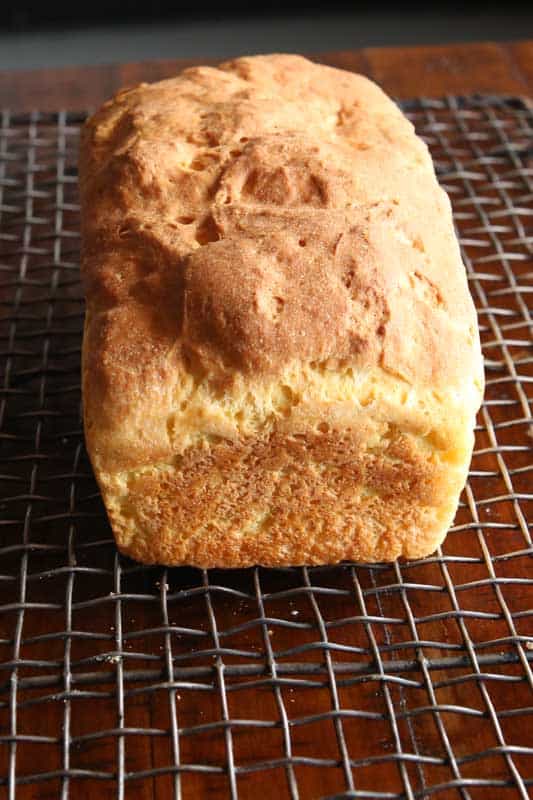
When the bread comes out of the oven, it’s done baking, right? Wrong! It’s almost done baking. Carryover baking occurs because the loaf is so hot. How hot? The loaf is steaming hot and it’s this steam that can cause problems for the gluten-free baker. Remember our friend xanthan gum? It loves to suck up water and it doesn’t stop doing this after baking. You want to ensure that the steam can escape from the baked loaf. If it doesn’t, the xanthan gum and starches can “grab” onto it. This leads to a gummy loaf of bread and soft crust.
To prevent a gummy loaf, remove the loaf from the baking pan and place it on a wire rack to cool. If the bread cools in the pan, the steam gets trapped and the loaf gets soggy, especially on the bottom.
Cutting
Once the bread is cool (or almost cool if you are impatient), it’s time to cut it. Use a serrated knife. Let me say that again, use a serrated knife. A smooth-blade knife will squish the bread. Lots of people ask me how to slice straight pieces of bread. Um….this is one that I can’t help with. They sell bread-cutting guides if this is an issue for you.
Storage
After doing all that work, you don’t want your loaf to get moldy or stale, right? Right!
Bread tastes best the day it’s baked. You can store it on the counter for a day or two. But if you know you aren’t going to eat an entire loaf in a day, here’s what I recommend: allow the loaf to cool, slice, place a piece of waxed paper or parchment between the slices, and slide the whole thing into a freezer bag. When you want a piece or two of bread, remove the bread from the freezer. You can either thaw at room temperature or microwave for 15 seconds.
BAKER’S NOTE: Never store bread in the refrigerator. It stales very quickly in the fridge. Either store bread on the counter overnight or freeze it.
Are you ready to make bread? Yeah, I thought so! Here’s the recipe. Enjoy it!
Shop the Recipe
The following are affiliate links. When you use them to shop, GlutenFreeBaking.com earns a commission.
Digital Scale
Liquid Measuring Cup
KitchenAid Stand Mixer
Bread Pan
Rubber Spatula
Oven Thermometer
Digital Thermometer
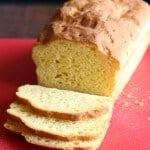
How to Make the Best Gluten-Free Sandwich Bread
Easy gluten-free sandwich. Makes a loaf that's tender and tasty!
Ingredients
- 3/4 cup warm water, about 110° F (6 ounces; 170 grams)
- 1 packet instant/rapid rise yeast (2 1/4 teaspoons; 7 grams)
- 1 1/2 cups millet flour (6 ounces; 170 grams)
- 1 cup tapioca starch (4 ounces; 113 grams)
- 2 tablespoons granulated sugar (1 ounce; 28 grams)
- 2 teaspoons xanthan gum
- 1 teaspoon table salt (not Kosher salt)
- 1/2 teaspoon baking powder
- 3 large eggs , whisked (about 5 ounces; 150 grams total, out of shell)
- 2 tablespoons olive or vegetable oil
- 1 teaspoon apple cider vinegar
- *if desired , replace the eggs with 3 large egg whites.
Instructions
-
Whisk together water and yeast in a small bowl. Allow to stand for five minutes.
-
In the bowl of a stand mixer, combine millet flour, tapioca starch, granulated sugar, xanthan gum, salt, and baking powder. Whisk to combine. Fit the stand mixer with the flat paddle attachment. Add the yeast mixture, eggs, oil, and vinegar. Mix on medium speed until smooth. Dough will be thin.
-
Spray an 8-1/2" by 4-1/2" by 2-3/4" loaf pan with nonstick cooking spray. Spread dough evenly into the pan. Spay a piece of plastic wrap with nonstick cooking spray and place plastic wrap loosely on the pan. Allow dough to double in size. This takes about one hour.
-
When dough has doubled in size, preheat oven to 350°F. Remove plastic wrap from the top of the pan.
-
Bake until the internal temperature of the bread reaches 210°F, about 45 minutes. (If the crust gets too dark before the internal temperature reaches 210°F, place a piece of foil onto the bread. This prevents the crust from burning.)
-
Remove bread from the oven and allow to cool for two minutes. Transfer bread to a wire cooling rack to cool completely.
-
When cool, slice into pieces with a serrated knife.
-
Store bread on the counter for up to three days or freeze sliced bread, wrapped in freezer wrap with waxed paper between each slice, and placed into a freezer container, for up to six weeks.
Recipe Notes
This easy recipe for gluten-free sandwich bread contains no corn, dairy, or soy. Be sure to use an 8-1/2" by 4-1/2" by 2-3/4" pan like this one by Chicago Metallic. If you don't have this pan, use a 9x5-inch pan. Bread baked in a 9x5-inch pan will bake up shorter than bread baked in an 8 1/2 x 4 1/2-inch pan.
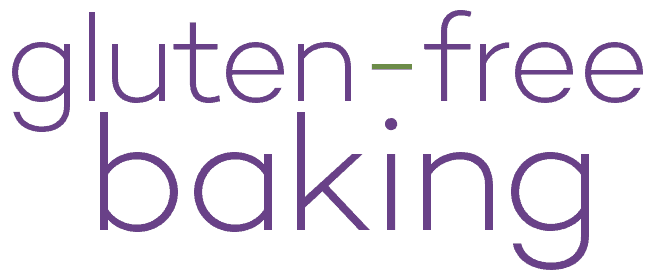


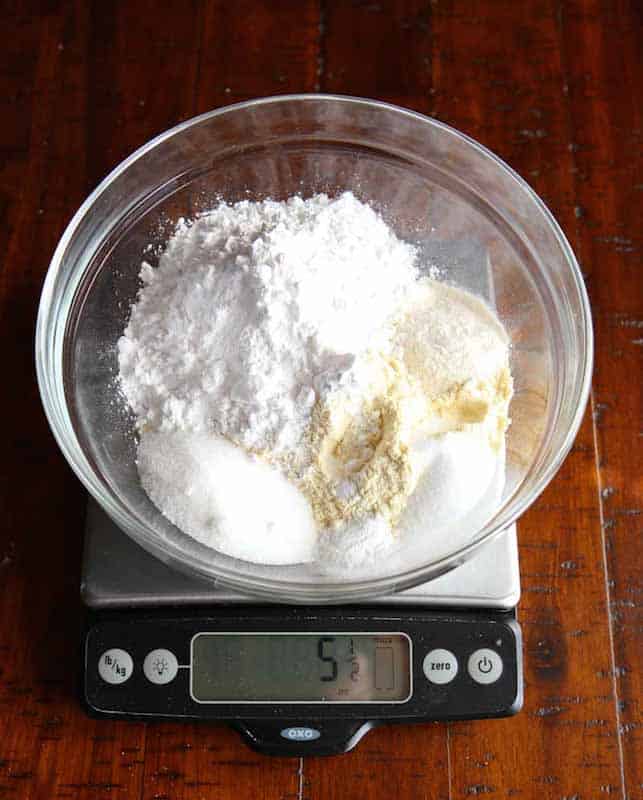
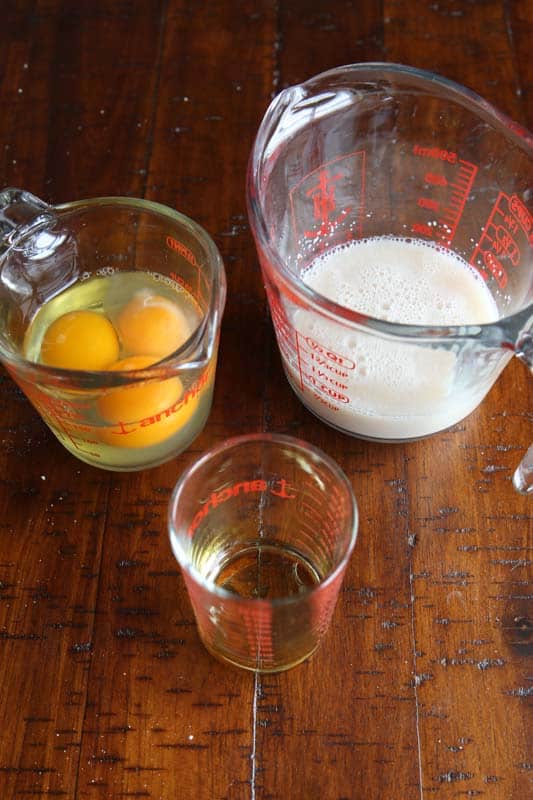

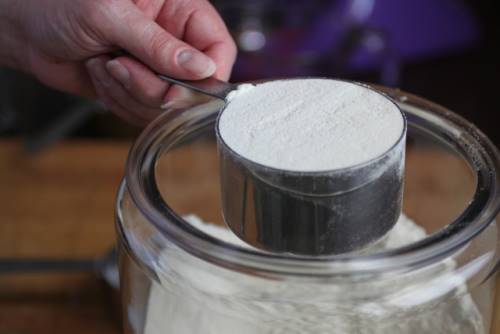
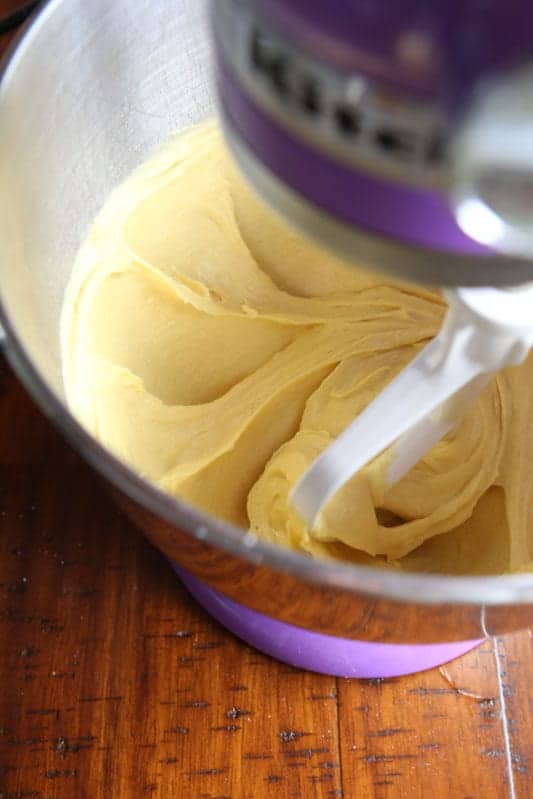
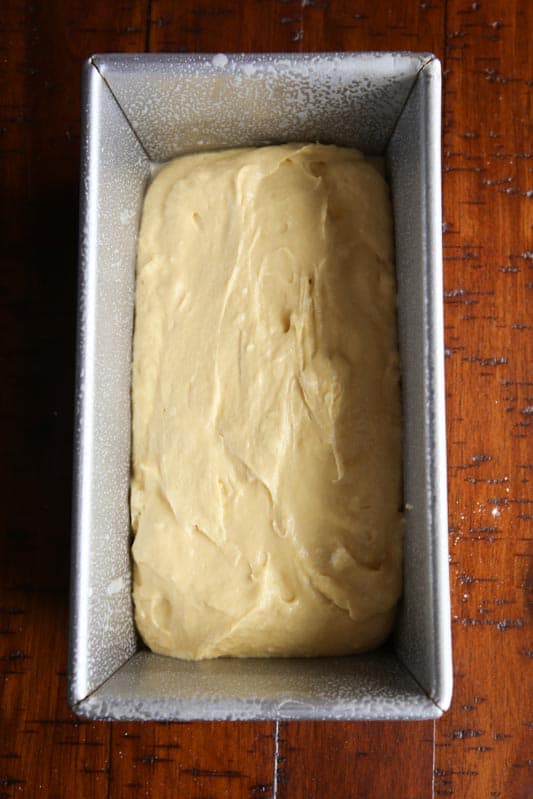
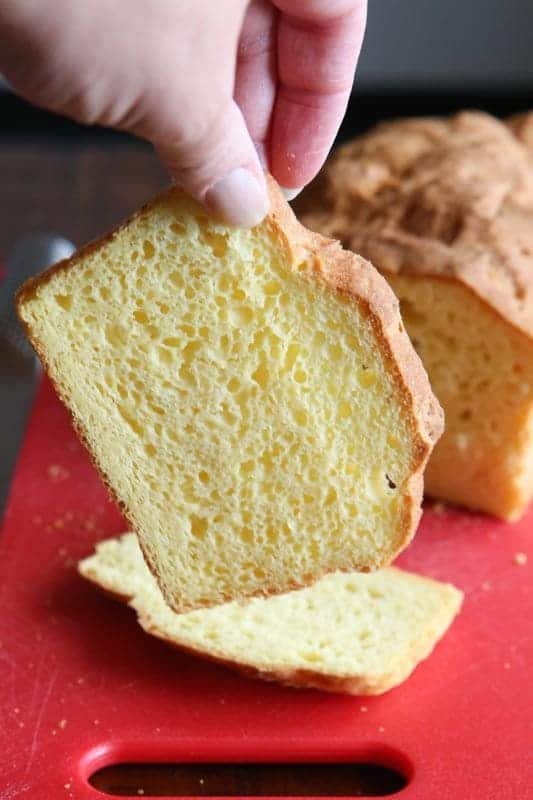
Rainy says
This is similar to a millet recipe I used to make, it was a wonderful bread as I am sure this is. But would like to inform your readers if they have a thyroid problem (as I do) millet is not a food you want to eat on a regular basis. If fact in some countries where they rely on millet for a daily meal it can cause thyroid problems.
Keep up the wonderful work!
Miriam Iversen says
This is very interesting! I am O positive blood group and there are certain foods that can cause a thyroid hormone imbalance in O group for instance any cabage or cauliflower (my substitute is brocolli). I will definately check in my book about millet. Thank you!
Elizabeth says
If it works for your diet, I hope you enjoy the bread!
B. Jack Maness says
I am new to gluten free.. no choice..My question is, can your sandwich bread and other recipes be done in a bread machine..
David says
I have made the gluten free dough in the bread machine and works great. However, do not let it rise in the bread machine as I find gluten free only does one rise. As soon as it’s finished mixing in the bread machine scrape it out into the baking pan, let it rise and then into the oven it goes. Oh, and remember to put the ingredients into the bread machine in the proper order keeping the yeast and salt away from each other.
Ereny Santos says
Hi,
Since I am allergic to egg whites, I was wondering if I could use only egg yokes and what is the ratio? thanks Ereny
Elizabeth says
Yes. You’d need to double the amount of egg yolks. As I’m sure you know, this will give you a richer bread.
Lucie says
You can substitute millet for quinoa. I made it and it is outstanding. Def the best gluten free bread I have made yet. In fact it is so similar to gluten bread it is unreal. I even tested it defrosted the next day and it does well as regular bread. Doesn’t have to be toasted. I would say after day 3 it starts to get a little dry but perhaps a airtight breadbin might mean that it lasts longer. Will be making this as the standard bread it our house from now on. Was actually very simple to make.
Tina Stalter says
This looks awesome! Thanks for the breakdown of the ingredients, and why they are used. I have a great recipe for bread, but am ready to try something new.
Tina
A.K.A. Funky Momma Creations
Judy Engram says
The bread is in the oven, just wondering how to know when it is done if I can’t measure the temperature, after the 45 minutes. Thanks
Sharon says
So I made this 3 times. Each yime it came out perfect. And it’s the best gluten free bread I have baked since I ve gone gluten free over 4 months now. It came out great with real bread consistency. The 2nd and 3rd time I altered it a bit adding about 1 tsp ground cinnamon l, 1 tbs flax seeds and about 1/4 cup raisins. Omg makes lovely breakfast toast. This one is definitely a keeper.
Elizabeth says
Yay! I’m glad you are enjoying the recipe!
Chase says
Are there other flours that would be suitable to substitute for millet, either in its entirety or as a blend?
Elizabeth says
To replace the millet, you could use sorghum flour or brown rice flour. There isn’t a blend I’d recommend for this recipe.
Debbie says
Is this recipe really corn free? I read Xanthum gum was started on a corn base? May I substitute guar gum?
Elizabeth says
Yes, the recipe is corn free. Xanthan gum can be feed glucose started from a number of different grains (corn, soy, and wheat) but the glucose contains no protein and is therefore safe for someone with a corn, soy, or wheat allergy. Here’s more on the topic: http://blog.bobsredmill.com/gluten-free/wiw-xanthan-gum/
Alexandra Cachia says
HI, this didnt rise at all for me 🙁 maybe you know what i could have done wrong? x x
Elizabeth says
If it didn’t rise at all, there was an issue with your yeast. What kind did you use? We can get to the bottom of this! 🙂
Roz says
I have IBS and egg whites are okay but not the yokes…sometimes I do add a little yoke but not much. Do you think this bread would turn out if only whites were used? I am in love with a millet bread I found in Florida and wish I could take many loaves back to Canada with me.
Thanks Roz
Elizabeth says
Oh! Good question! It should work. However, you’d need to double the amount of egg whites to make up for the lack of yolks.
Karen says
Have you ever calculated the cost per loaf?
Elizabeth says
Good question. I haven’t, simply because ingredients vary from region to region.
Leslee says
I am wondering how much longer I can cook it if it isn’t up to temp? I’ve had it in 60 minutes and it’s still not 210! Smells delish tho!!!
Elizabeth says
It would depend on what temperature it was at when you took the reading; sometimes five more minutes does the trick.
If it never got to 210 degrees, I’d check your thermometer to ensure it’s accurate.
Jai says
So I’ve made this a few times. At first I was using the small loaf pan, and everything turned out great. However, I tried doubling the recipe and baking it in a large loaf pan. It’s tastes fine and rises beautifully, but it keeps falling after I take it out of the oven. What can I do to keep it from falling? I’ve tried adjusting how long I let the dough rise before I put it in and still get the same result.
Elizabeth says
Jai–I’m sorry you’re having trouble. I’ve found this recipe works best in the smaller pan. 🙁
Eric says
Fantastic recipe, and the wife (who has no gluten issues) loves it too. Actually it was her suggestion to make a loaf with some zip so the 2nd loaf I tried I added 2 serrano peppers (with seeds and ribs) and 2 sprigs of rosemary…it was out of this world fantastic. I cut a couple slices, buttered them and sprinkled with garlic powder and threw them back in the oven to heat up for a steak and sauteed mushroom dinner tonight…mmmmm!!
The only issue I’m having with these loaves is that they’re dropping in the middle, not too bad but enough that it’s definitely noticeable. The wife thinks it could be the baking powder and I’m just looking for all possibilities so it stays full
Elizabeth says
Eric–
Glad you are enjoying the bread! Let’s try to get to the bottom of the sinking issue. Sometimes when a loaf rises too high, it drops. Could this be the issue? I haven’t had the loaf sink but I’ll try to replicate it and get back to you with a solution!
Amy says
Could this recipe be done with a breadmaker or only in the oven?
Elizabeth says
It can be made in a bread machine with a two pound capacity. (I use the Zojorushi bread machine.) 🙂
Isabelle Dowlin says
How would one make this in a bread machine if you have the time to answer this? I am going gluten free because I think it is the route of all my health problems. I was thinking of making homemade bread. I have heard a lot about using a bread machine. Does takes away the baking in the oven, correct? If you can explain anything at all that would be wonderful. I love how in depth your recipe is.
Elizabeth says
Hi Isabelle!
I’m currently working on a bread machine guide. 🙂 The short answer is: yes. This recipe can be made in a two pound bread machine. I like the Zojirushi machine. It does a great job with gluten-free bread. Here are the settings I use:
Preheat: 10 minutes
Rise one and two: off
Rise three: 60 minutes
Bake time: 70 minutes
Warm cycle: off
Crust color: medium
I hope this helps!
Rebecca Evers says
I am looking forward to trying this recipe in my zojirushi. Can you tell me if you use the knead cycle after putting the wet and then dry ingredients in the bread pan? Or do you mix it per your instructions and then put the batter in the bread pan to rise and bake only? Thank you!
Elizabeth says
I set my ZO the homemade setting which I set as follows:
1. Preheat 10 minutes
2. Knead: 18 minutes
3. Rise One: Off
4. Rise Two: Off
5. Rise Three: One Hour
6. Bake: 1 Hour and 10 Minutes
7. Keep Warm: Off
I add the liquid ingredients to the machine and put the dry ingredients over the top. I hit start. About halfway through kneading, I open the machine once and scrap down the sides of the pan with a soft rubber spatula.
Have fun!
Erin says
Could I make this bread with an egg substitute? I have a gluten and egg allergy, and finding a gluten and egg free bread seems to be impossible!
Elizabeth says
I don’t think the recipe works with ann egg substitute. 🙁 I’ll have to work on a gluten-free and egg-free sandwich bread recipe.
Brad says
I am making my second batch using the EnerG brand egg replacer. The first batch turned out great.
Elizabeth says
Oooooh! Awesome!
Sally says
Hi, I do not have a bread thermometer, so how long should I bake this for please,,any suggestions.
Thank you, Sally
Elizabeth says
Hi Sally! It should take about 45 minutes or so. Enjoy the bread!
Kireii91 says
Hi Elizabeth,
I just made this loaf of gluten free millet loaf. But mine came out with a bitter after taste 🙁 I bought my flour 2 weeks ago and the expiry date states 2017. Does millet flour have this distinct bitter after taste or did I do anything wrong?
I thought I finally found an alternative to normal bread and now this happens 🙁
Hope you to hear from you soon!!
Elizabeth says
Hi Kireii!
I don’t find millet to have a bitter taste. However, taste is so subjective that it might not be the right flour for you. Feel free to try the recipe with either brown rice flour or sorghum flour in place of the millet. It will work well with either of those flours. (Be sure to swap 1:1).
That said, you might have some millet flour that’s “off”. Not bad, per se, but it could have picked up an odor along the way from the factory to you. If you are up to it, you could always get another bag of millet (from a different store) and see if that solves the problem.
I hope that helped!
Kireii91 says
Alrighty! I shall try this recipe with brown rice flour. Thank you for your tip! 🙂
Elizabeth says
Let me know how it goes!
Kireii91 says
Hello Elizabeth!
I replaced the millet flour with brown rice flour. But i didnt make this bread recipe. I made some pancakes instead using similar ingredients because i didn’t want to waste the food if it fails again. But i still get the awful bitter taste… So this means that the millet flour didnt cause the bitter taste!
I was so determined to find out what was causing the taste and so I tasted every single ingredient raw. FINALLY, I found it. It was my tapioca starch. But it didn’t expire 🙁 So i replaced it with corn starch and the awful bitter taste was gone 🙂
Now i can make your bread recipe without any worries! 🙂
I have one question though… Since I am able to interchange millet and brown rice flour 1 for 1, then can I use 85g millet and 85g brown rice flour in your recipe?
Thank you for your reply!
Kriss says
Hi Elizabeth,
I made your Sandwich loaf today. I didn’t have millet flour, substituted with Bobs Red Mill sweet sorghum instead. The flavor is nice and the aroma is just like wheat bread, the crust is crunchy and nicely browned. This is the first GF bread I’ve tried making. And will continue to use your recipe for bread and rolls.
Therefore I have a few question:
1. Is the moistness typical of gluten free bread? Or did I add to much oil or water? Would adding non fat dry milk change the recipe?
2. I have looked at many GF mixes in the store and on the web, and find almost all use rice flours. I find rice flours to gritty for me. Are there non gritty flours I can substitute and still produce a tasty and typical product with a smooth texture? Thank you.
Elizabeth says
Glad you enjoyed the recipe!
To answer your questions:
1. Is the moistness typical of gluten free bread? Or did I add to much oil or water? Would adding non fat dry milk change the recipe?
If you followed the recipe, you didn’t add too much oil or water. Gluten-Free breads tend to be more moist than traditional breads. You can replace the water with milk but I would not add dry milk to this recipe.
2. I have looked at many GF mixes in the store and on the web, and find almost all use rice flours. I find rice flours to gritty for me. Are there non gritty flours I can substitute and still produce a tasty and typical product with a smooth texture? Thank you.
Millet and sorghum flour are good replacements for brown rice flour. However, without seeing the recipe you plan to use, it’s hard to say for certain.
Kriss says
Thank you for your prompt reply.
I made your Soda Bread recipe this morning. Didn’t have white rice flour so used half sorghum and half brown rice flours instead. It fell in the middle. Should I have add more baking powder or baking soda? I used lemon juice to sour the milk since I didn’t have buttermilk. Otherwise I followed the recipe.
The batter was thicker than what your pictures show, so I stirred in some cream (yum) to thin it a bit. Still the batter looked more like a fluffy cake batter. Was that because of the sorghum flour?
Thank you so much for your help, I’m new at GF baking, this is an entirely new learning curve for me.
Elizabeth says
I’m guessing that the addition of cream thinned the batter too much. And, in this recipe, true buttermilk makes a big difference. I think the combination of those two changes might have made it sink. That said, was it baked all the way through? That could always cause it to collapse.
Kriss says
Yes, it tested done in the middle. I’m the only one eating GF, can I cut the muffin and bread recipes in half?
I’m going to keep trying recipes until I get the hang of how each ingredient works because I feel better on a GF diet.
I appreciate our website, it has lots of good information. And you are very helpful.
Thank you….Blessings, K
Elizabeth says
Yup! The muffin recipes can be cut in half. The only recipe that I don’t advise reducing are ones that use yeast, as they tend not to work the same when either doubled or halved.
Have fun baking!
Julie says
Hi Elizabeth,
This recipe looks wonderful. Would it work if I replaced arrowroot for the tapioca? I cannot eat tapioca : (
Elizabeth says
Good question! I’m not 100% sure. Arrowroot isn’t as elastic as tapioca. Can you do corn? I think I’d do half arrowroot and half corn to replace the tapioca.
Julie says
Unfortunately I cannot do corn either. I’m in a real pickle where gluten free baking is concerned : (
Sonce says
Hello! I know this comment was quite a while ago, but I also cannot tolerate tapioca. I made this recipe using half arrowroot and half potato starch in place of the tapioca. It came out very well. Nice texture and it was lovely to eat non-toasted bread! Thick slices make an excellent delivery system for butter.
Elizabeth says
Great! Glad to hear it worked!